Industrial Automation’s Future

There’s no denying that many factories and warehouses are now using automation more, to increase production and boost quality, as it is beneficial. However, it can be said that the use of automation is still fairly old, there are much more recent developments that can lead to continuous marginal improvement. This is mostly because once production starts, it can be hard to make large changes.
This blog will explore if automation could allow operations to make certain adjustments as they go, even if they are minor, for instance, ones that have come to light from data. This will allow businesses to go further with automation, making them more advanced and more competitive. From modern industrial internet of things, technologies to software, machine learning, AI and more, the most recent advancements in automation need to be utilised.
The AIoT Approach
The AIoT Approach is typically led by operational know-how, this is based on using digital automation skills for industrial-led applications, and it is effective. However, this sort of approach needs specialist skills and planning, companies need to have these things in place. However, once they are, it is well worth the benefits, have you thought of hiring experts for your team?
Another way to do this is by using operator-driven intelligence so your automation is boosted more than traditional methods. This happens as technology and human experts work seamlessly together. AIoT thrives from practical knowledge and human experience working in harmony, it is smart decision-making that will improve performance.
Operator Friendly AIoT
It’s important to implement operator-friendly AIoT correctly, 3 stages are used for this.
- Connected: This allows businesses to have reliable data from a range of sources that can easily be accessed, usually through soft sensors.
- Predictive: Once IIoT data is gathered, this analytical stage will provide data and insights so you’re able to predict what's coming next.
- Prescriptive: After predictions have been made, AI/ML can allow you to make decisions that will see results. From low-code control to autonomous operation, there are different stages you can choose based on your needs.
Humans And Machines
Humans and machines must work together closely with each other to be successful to create quality results. Traditional automation relies less on this partnership and more advanced automation relies on this more and more, they have to react to each other. For example, for AIoT systems, operators can use their skills to ensure it’s optimised, it’s key to understand these interactions and make a difference.
Boosting Operators
Now more than ever before, there is a need for advanced automation and the benefits it brings, particularly in engineering and manufacturing operations. This collaboration between humans and ML/AI will get your business closer to its goals, but this doesn’t all have to be done at once. Start by having an effective AIoT and work from there, optimising operations a little bit more every day.
Enjoyed reading this blog? Want some more articles like this about AI and the future of engineering? Visit our news and inspiration page today!